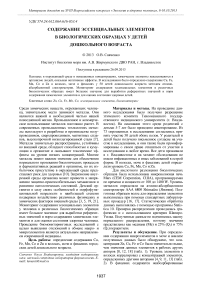Содержание эссенциальных элементов в биологических образцах у детей дошкольного возраста
Автор: Савченко Ольга Владимировна
Журнал: Известия Самарского научного центра Российской академии наук @izvestiya-ssc
Статья в выпуске: 3-6 т.15, 2013 года.
Бесплатный доступ
Находясь в окружающей среде в повышенных концентрациях, химические элементы накапливаются в организме людей, оказывая негативные эффекты. В исследовании было определено содержание Cu, Fe, Mn, Co и Zn в волосах, моче и фекалиях у 50 детей дошкольного возраста методом атомно-абсорбционной спектрометрии. Мониторинг содержания эссенциальных элементов в различных биологических образцах имеет большое значение для выработки референтных значений и норм содержания химических элементов и для оценки состояния здоровья детей.
Эссенциальные элементы, биомониторинг
Короткий адрес: https://sciup.org/148202136
IDR: 148202136 | УДК: 574.24:612.064:616-053.4
Список литературы Содержание эссенциальных элементов в биологических образцах у детей дошкольного возраста
- Angerer, J. Human biomonitoring: State of the art/J. Angerer, U. Ewers, M. Wilhelm//Int. J. Hyg. Environ. Health. 2007. Vol. 210, № 3-4. P. 201-228.
- Barbosa, F.Jr. A Critical Review of Biomarkers Used for Monitoring Human Exposure to Lead: Advantages, Limitations, and Future Needs/F.Jr. Barbosa, J.E. Tanus-Santos, R.F. Gerlach, P.J. Parsons//Environmental Health Perspectives. 2005. Vol. 113, №12. P. 1669-1674.
- Cesar, C. Environmental impact on child health. Washington, D.C. PAHO, 2000. 36 p.
- Chiba, M. Element concentrations in hair of children living in environmentally degraded districts of the East Aral Sea region/M. Chiba, K. Sera, M. Hashizume et al.//Journal of Radioanalytical and Nuclear Chemistry. 2004. Vol. 259, № 1. P. 149-152.
- Gebbers, J.O. Environmental health. Medical aspects -children unique vulnerability -perception of the environment//Schweiz Rundsch Med Prax. 2007. Vol. 96, № 12. P. 451-456.
- Gwiazda, R. A Noninvasive Isotopic Approach to Estimate the Bone Lead Contribution to Blood in Children: Implications for Assessing the Efficacy of Lead Abatement/R. Gwiazda, C. Campbell, D.A. Smith//Environ Health Perspect. 2005. Vol. 113, № 1. P. 104-110.
- Handbook on the Toxicology of Metals. Ed.: Nordberg G.F., Fowler B.A., Nordberg M., Friberg L.T. Third Edition. Elsevier. 2007. 992 p.
- Heitland, P. Biomonitoring of 30 trace elements in urine of children and adults by ICP-MS/P. Heitland, D. Köster//Clin. Chim. Acta. 2006. Vol. 365, № 1-2. P. 310-318.
- Lech, T. Lead, copper, zinc, and magnesium levels in hair of children and young people with some disorders of the osteomuscular articular system//Biol Trace Elem Res. 2002. Vol. 89, № 2. P. 111-125.
- Mamtani, R. Metals and Disease: A Global Primary Health Care Perspective/R. Mamtani, P. Stern, I. Dawood, S. Cheema1//Journal of Toxicology. 2011 DOI: 10.1155/2011/319136
- Mohammed, N.K. Elemental Contents in Hair of Children from Two Regions in Dar Es Salaam//International Journal of Analytical Chemistry. 2012 DOI: 10.1155/2012/495043
- Moreno, M.E. Biomonitoring of metal in children living in a mine tailings zone in Southern Mexico: A pilot study/M.E. Moreno, L.C. Acosta-Saavedraa, D. Meza-Figueroac et al.//International Journal of Hygiene and Environmental Health. 2010. Vol. 213, № 4. P. 252-258.
- Ogboko, B. Trace Element Indices in Hair and Saliva of School Children//J. Basic. Appl. Sci. Res. 2011. Vol. 1, № 3. P. 169-177.
- Parsons, P.J. Atomic spectrometry and trends in clinical laboratory medicine/P.J. Parsons, F. Barbosa//Spectrochim Acta Part B Atom Spectrosc. 2007. Vol. 62. P. 992-1003.
- Rodriques, J.L. Evaluation of the use of human hair for biomonitoring the deficiency of essential and exposure to toxic elements/J.L. Rodriques, B.L. Batista, J.A. Nunes et al.//Science of The Total Environment. 2008. Vol. 405, № 1-3. P. 370-376.
- Rodushkin, I. Application of double focusing sector field ICP-MS for multielemental characterization of human hair and nails/I. Rodushkin, M.D. Axelsson//Science of the Total Environment, Part I. 2000. Vol. 250, № 1-3. P. 83-100.
- Rodushkin, I. Determination of low-abundance elements at ultra-trace levels in urine and serum by inductively coupled plasma-sector field mass spectrometry/I. Rodushkin, E. Engstrom, A. Stenberg, D.C. Baxter//Anal Bioanal Chem. 2004. Vol. 380, № 2. P. 247-257.
- Rodushkin, I. Application of inductively coupled plasma sector field mass spectrometry for elemental analysis of urine/I. Rodushkin, F. Ödman//J. Trace Elem. Med. Biol. 2001. Vol. 14, № 4. P. 241-247.
- Schneider, D. Children's environmental health: Reducing risk in a dangerous world/D. Schneider, N. Freeman. -Washington, DC: American Public Health Association. 2000. 324 p.
- Shenkin, A. Micronutrients in health and disease//Postgrad Med. J. 2006. Vol. 82, № 971. P. 559-567.
- Wigle, D.T. Environmental hazards: evidence for effects on child health/D.T. Wigle, T.E. Arbuckle, M. Walker et al.//Journal of Toxicology and Environmental Health, Part B: Critical Reviews. 2007. Vol. 10, № 1-2. P. 3-39.


